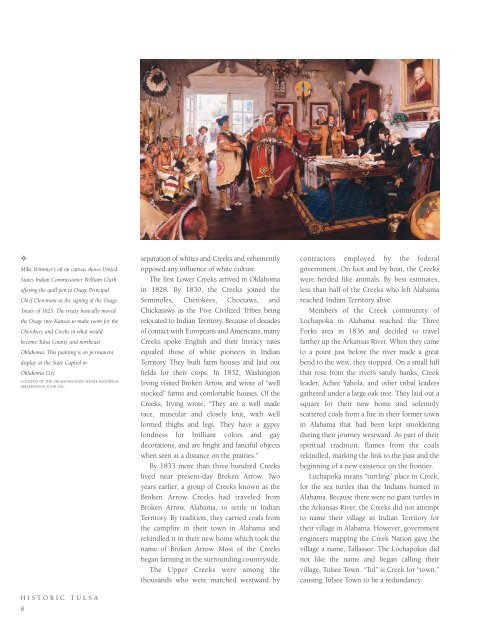Historic Tulsa
An illustrated history of the city of Tulsa, Oklahoma, paired with the histories of companies, families and organizations that make the region great.
An illustrated history of the city of Tulsa, Oklahoma, paired with the histories of companies, families and organizations that make the region great.
Create successful ePaper yourself
Turn your PDF publications into a flip-book with our unique Google optimized e-Paper software.
✧<br />
Mike Wimmer’s oil on canvas shows United<br />
States Indian Commissioner William Clark<br />
offering the quill pen to Osage Principal<br />
Chief Cleremont at the signing of the Osage<br />
Treaty of 1825. The treaty basically moved<br />
the Osage into Kansas to make room for the<br />
Cherokees and Creeks in what would<br />
become <strong>Tulsa</strong> County and northeast<br />
Oklahoma. This painting is on permanent<br />
display at the State Capitol in<br />
Oklahoma City.<br />
COURTESY OF THE OKLAHOMA STATE SENATE HISTORICAL<br />
PRESERVATION FUND, INC.<br />
HISTORIC TULSA<br />
8<br />
separation of whites and Creeks and vehemently<br />
opposed any influence of white culture.<br />
The first Lower Creeks arrived in Oklahoma<br />
in 1828. By 1830, the Creeks joined the<br />
Seminoles, Cherokees, Choctaws, and<br />
Chickasaws as the Five Civilized Tribes being<br />
relocated to Indian Territory. Because of decades<br />
of contact with Europeans and Americans, many<br />
Creeks spoke English and their literacy rates<br />
equaled those of white pioneers in Indian<br />
Territory. They built farm houses and laid out<br />
fields for their crops. In 1832, Washington<br />
Irving visited Broken Arrow, and wrote of “well<br />
stocked” farms and comfortable houses. Of the<br />
Creeks, Irving wrote, “They are a well made<br />
race, muscular and closely knit, with well<br />
formed thighs and legs. They have a gypsy<br />
fondness for brilliant colors and gay<br />
decorations, and are bright and fanciful objects<br />
when seen at a distance on the prairies.”<br />
By 1833 more than three hundred Creeks<br />
lived near present-day Broken Arrow. Two<br />
years earlier, a group of Creeks known as the<br />
Broken Arrow Creeks had traveled from<br />
Broken Arrow, Alabama, to settle in Indian<br />
Territory. By tradition, they carried coals from<br />
the campfire in their town in Alabama and<br />
rekindled it in their new home which took the<br />
name of Broken Arrow. Most of the Creeks<br />
began farming in the surrounding countryside.<br />
The Upper Creeks were among the<br />
thousands who were marched westward by<br />
contractors employed by the federal<br />
government. On foot and by boat, the Creeks<br />
were herded like animals. By best estimates,<br />
less than half of the Creeks who left Alabama<br />
reached Indian Territory alive.<br />
Members of the Creek community of<br />
Lochapoka in Alabama reached the Three<br />
Forks area in 1836 and decided to travel<br />
farther up the Arkansas River. When they came<br />
to a point just before the river made a great<br />
bend to the west, they stopped. On a small hill<br />
that rose from the river’s sandy banks, Creek<br />
leader, Achee Yahola, and other tribal leaders<br />
gathered under a large oak tree. They laid out a<br />
square for their new home and solemnly<br />
scattered coals from a fire in their former town<br />
in Alabama that had been kept smoldering<br />
during their journey westward. As part of their<br />
spiritual tradition, flames from the coals<br />
rekindled, marking the link to the past and the<br />
beginning of a new existence on the frontier.<br />
Lochapoka means “turtling” place in Creek,<br />
for the sea turtles that the Indians hunted in<br />
Alabama. Because there were no giant turtles in<br />
the Arkansas River, the Creeks did not attempt<br />
to name their village in Indian Territory for<br />
their village in Alabama. However, government<br />
engineers mapping the Creek Nation gave the<br />
village a name, Tallassee. The Lochapokas did<br />
not like the name and began calling their<br />
village, Tulsee Town. “Tul” is Creek for “town,”<br />
causing Tulsee Town to be a redundancy.
















